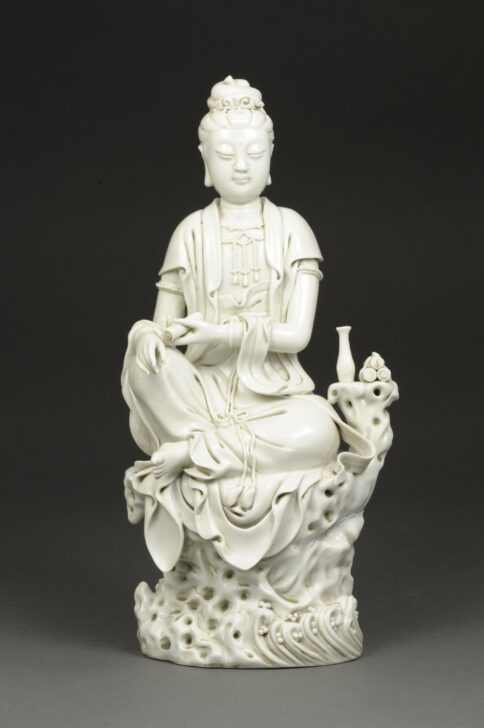Guanyin

Description
Subject Matter:
"In Chinese Buddhism, Guan Yin is synonymous with the Bodhisattva Avalokitesvara, the pinnacle of mercy, compassion, kindness and love.
Along with Buddhism, Guan Yin's veneration was introduced into China as early as the 1st century AD, and reached Japan by way of Korea soon after Buddhism was first introduced into the country from the mid-7th century.
Representations of the Bodhisattva in China prior to the Song Dynasty (960-1279 AD, Northern - and Southern Song Dynasty) were masculine in appearance.
It is generally accepted that Guan Yin originated as the Sanskrit Avalokitesvara, which is her male form, since all representations of Bodhisattva were masculine.
Later images might show female and male attributes, since a Bodhisattva, in accordance with the Lotus Sutra, has the magical power to transform the body in any form required to relieve suffering, so that Guan Yin is neither woman nor man. In Mahayana Buddhism, to which Chinese Buddhism belongs, gender is no obstacle to Enlightenment.
As the Lotus Sutra relates, the Bodhisattva Kuan Shih Yin, "by resort to a variety of shapes, travels in the world, conveying the beings to salvation."
The representation in China was further interpreted in an all-female form around the 12th century, during the Ming Dynasty (1368- 1644 AD).
In the modern period, Guan Yin is most often represented as a beautiful, white-robed woman, a depiction which derives from the earlier Pandaravasini form.
Guan Yin is usually shown in a white flowing robe - white being the symbol of purity -, and usually wearing necklaces of Indian/Chinese royalty...A necklace or rosary is associated with her calls upon Buddha for succor, each bead of it representing all living beings and the turning of the beads symbolizes that Guan Yin is leading them out of their state of misery and repeated rounds of rebirth into nirvana, hence the beads represent enlightenment. Should a book or scroll of papers be within the portrayal, it is representing the Dharma, the teaching of Buddha or the sutra, the Buddhist text, Guan Yin is said to have constantly recited from."
https://www.nationsonline.org/oneworld/Chinese_Customs/Guan_Yin.htm
Physical Description:
Guanyin is seated in a posture of royal ease on a decorative chair with a small table holding a small jar and three scrolls. Her left arm is resting upon her left knee while her right arm is crossed in front of her holding another scroll. She is wearing a robe, a necklace, and her eyes are closed,
Usage Rights:
If you are interested in using an image for a publication, please visit https://umma.umich.edu/request-image/ for more information and to fill out the online Image Rights and Reproductions Request Form.